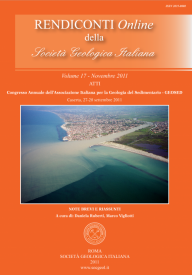
Biogeochemical characterization of the laminated microbialites in the Lower Devonian Kess-Kess mounds (Hamar Laghdad, Morocco)
Demasi F. (*), Guido A. (*), Mastandrea A. (*), Tosti F. (*) & Russo F. (*)
(*) Dipartimento di Scienze della Terra, Museo di Paleontologia, Università della Calabria, Via Bucci Cubo 15b, 87036 Rende (CS), Italy. E-mail: fabio.demasi@unical.it
Volume: 17/2011
Pages: 83-87
Abstract
The Kess-Kess mounds of the Hamar Laghdad Ridge, SE Morocco, are spectacular carbonate buildups because the differential erosion, highlighted their original shapes and the relationships with associated beds. The origin of these buildups is still under debate and the most consistent hypothesis is related to submarine hydrocarbon seapage or less probably to hydrothermal vents in which bacteria and/or archaea played a prominent role in the carbonate biomineralization.
To investigate the traces of prokaryotic metabolic activity, which possibly caused the laminated microbialite precipitation, the research was focused on micro-nanomorphology of the very fine dark and white wrinkled laminations and biogeochemical analyses of their organic remains. Epifluorescence observations put in evidence a high organic matter content mainly in the dark laminae. The geochemical characterization of extracted organic matter was performed through the functional group analyses by FT-IR Spectroscopy. FT-IR parameters indicate a marine origin and low thermal evolution for the organic compounds. The organic matter, correlated to the fine laminated micrite, is characterized by the presence of stretching νC=C vibrations attributable to alkene and/or unsatured carboxylic acids. These organic compounds are likely to be synthesized by bacteria and/or archaea communities. Gas Cromatography-Mass Spectrometry analyses on these low thermal maturity organic matter remains will reveal specifi c bacterial/archaeal biomarkers. These data will help to identify the metabolic pathways inducing the micrite precipitation in the Kess Kess mounds.
Keywords
Get Full Text